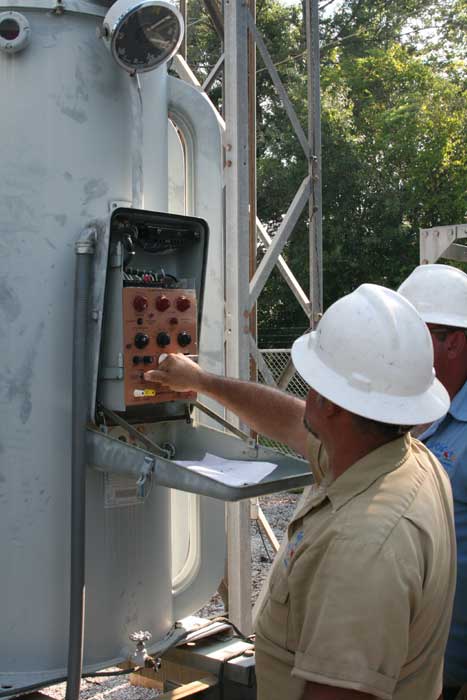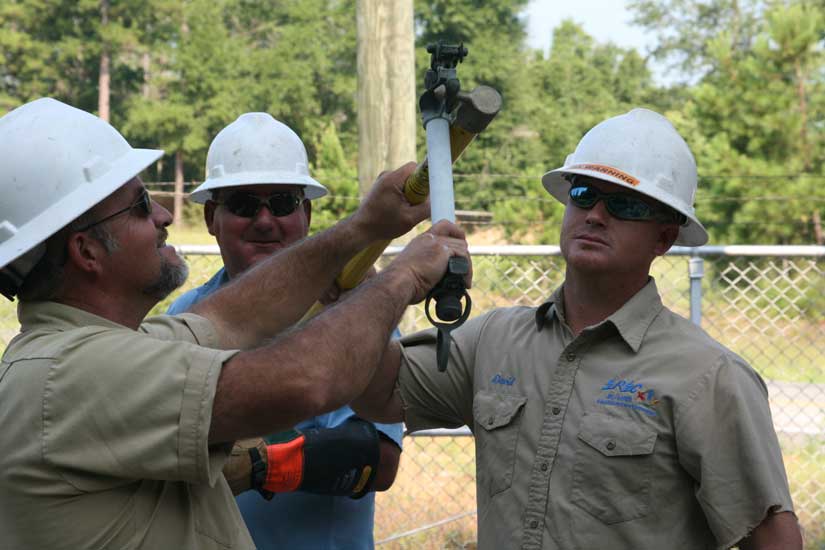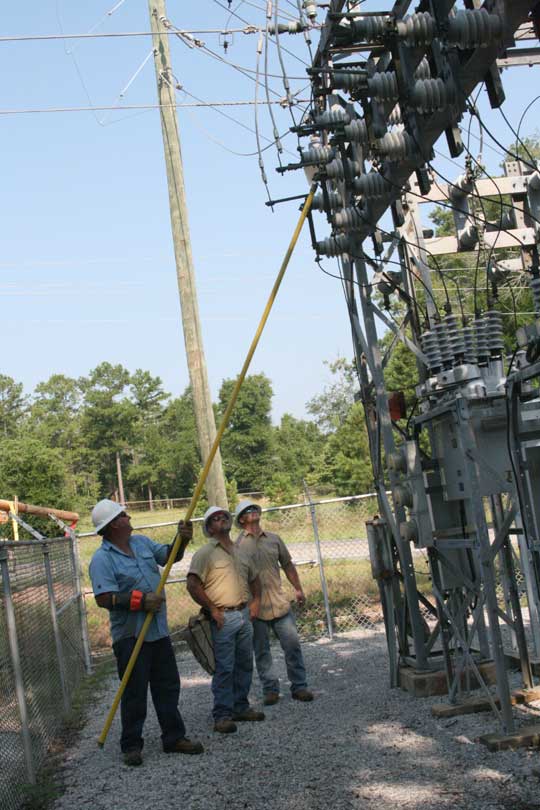Ever Wonder What Happens When Your Power Goes Out?
July 15, 2010
Power outages were reported across the North Escambia area Wednesday night as a line of storms moved through the area. But have you ever thought about what happens when your power goes out? NorthEscambia.com thought we would take a look at the behind the scenes things that take place to get your power back on.
Our scenario below involves Escambia River Electric Cooperative and a hypothetical power outage in Walnut Hill. The events could just as well happen in any community in the North Escambia area on EREC, Gulf Power, Alabama Power, or Southern Pine Electric Cooperative.
Here’s our little story, “When the Lights Go Out”:
You were on your couch watching the TV early last night. The main storm has passed, and the rain outside has just about lulled you into a quick early evening nap.
Then it happens. Your power blinks one, two, three times and it’s off. You make your way in the dark to the kitchen where your glow-in-the-dark EREC magnet on the refrigerator is illuminated enough so that you can read the outage number. You call the number, 1-877-OUT-EREC, and follow the voice prompts to report your home’s outage. Your job is done.
What happens now? First of all, let’s set up the scenario for our hypothetical outage. Let’s say you live on Arthur Brown Road in Walnut Hill. This address receives power from the Oak Grove substation, just across the road from the Oak Grove Park on North Highway 99. You are assuming the evening’s thunderstorm is the culprit for your home being left in the dark. You know the proper action for you to take is to call the EREC outage number which you have done. Now, here’s the sequence of events which will take place to restore your power as quickly and safely as possible.
In our power outage scenario, your call comes in to the dispatch center and your name and address appear immediately on the computer screen. The dispatcher then contacts the on-call EREC crew to make repairs. Since the two-man crew is on-call for the evening, each crewman has driven home an EREC truck loaded with equipment and supplies necessary to repair any typical outage that might occur. So when the dispatch call is received, each crewman leaves his home and heads directly to the site of the outage. He does not need to take extra time to go by the EREC facility and get the vehicle, equipment and supplies needed to repair the outage.
 Upon arrival to the outage location, the crew investigates the reason for the power failure. Meanwhile they have received additional calls from the dispatch center letting them know there are other nearby houses on Arthur Brown Road, Corley Road and Juniper Street that are experiencing outages as well. After assessment of the power system, the crew determines that the cause of the outage is an RE failure (an oil reclosure breaker) in the substation due to a lightning strike.
Upon arrival to the outage location, the crew investigates the reason for the power failure. Meanwhile they have received additional calls from the dispatch center letting them know there are other nearby houses on Arthur Brown Road, Corley Road and Juniper Street that are experiencing outages as well. After assessment of the power system, the crew determines that the cause of the outage is an RE failure (an oil reclosure breaker) in the substation due to a lightning strike.
This can be handled quickly by the two-man crew so there is no need for additional personnel to be called in for assistance. The crew repairs the damage and calls the dispatch center to let them know all power has been restored. The dispatch center then calls back each member that has reported a power outage to be sure they do have power.
For more photos from inside the Oak Grove Power substation, click here.
The purpose of this story is to create a picture of what is actually happening during a typical power restoration. This is only a possible scenario and, of course, there are many different reasons why your power can go out.
“Although we cannot imagine all the power outage scenarios that can happen, there is one thing we can be sure of. EREC will be there to restore your power as quickly as possible in the dead of night, in the middle of terrible storms or whatever the case may be – EREC crews will do what needs to be done to get the lights back on,” said Sabrina Owens, EREC’s marketing director.
She said that in the case of major outages such as those that occur with hurricanes or other severe weather, specific procedures are in place to restore power to the most people in the shortest amount of time. The following steps describe power restoration after a storm.
- Transmission towers and lines supply power to one or more transmission substations. These lines seldom fail, but they can be damaged by a hurricane or tornado. Tens of thousands of people could be served by one high-voltage transmission line, so if there is damage here it gets attention first.
- Escambia River EC has several local distribution substations, each serving thousands of members. When a major outage occurs, the local distribution substations are checked first. A problem here could be caused by failure in the transmission system supplying the substation. If the problem can be corrected at the substation level, power may be restored to a large number of people.
- Main distribution supply lines are checked next if the problem cannot be isolated at the substation. These supply lines carry electricity away from the substation to a group of members, such as a town or housing development. When power is restored at this stage, all members served by this supply line could see the lights come on, as long as there is no problem farther down the line.
- The final supply lines, called tap lines, carry power to the utility poles or underground transformers outside houses or other buildings. Line crews fix the remaining outages based on restoring service to the greatest number of members.
- Sometimes, damage will occur on the service line between your house and the transformer on the nearby pole. This can explain why you have no power when your neighbor does. EREC needs to know you have an outage in this type of situation so that a service crew can repair it.
Members themselves (not the cooperative) are responsible for damage to the service installation on the building. The member will need to have a licensed electrician make these repairs.
For more photos from inside the Oak Grove Power substation, click here.
Special thanks to Sabrina Owens at EREC for her assistance with this story from our files , and to the linemen that assisted with the photographs. It’s worth noting that the photographs were taken on a nice sunny morning rather than during a real power outage after a storm due to the dangers of standing in a power substation after a storm has just passed.
Pictured above: EREC prepare to fix an oil reclosure breaker (RE) failure inside the Oak Grove power substation. Pictured below: That breaker is installed on a transmission line headed to the Arthur Brown Road area of Walnut Hill. NorthEscambia.com file photos, click to enlarge.
Comments
6 Responses to “Ever Wonder What Happens When Your Power Goes Out?”





One thing is for sure, the power companies want the power retored as bad or worse than we do. After all they are not making money if the meters are not turning, not to mention the cost of the repairs!! If there was a sure fired way to prevent outages from ever happening again, they would be on it like white on rice!
I have had EREC for many years and with the usual hurricanes and loss of power,I can honestly say we have the best co-op anywhere.They hire great people who work out in weather most of us wouldn’t work in.
Even with a rare outage,the power isn’t off long enough to get upset.After Hurricane Ivan,I was so impressed with the job these men do.Long hours,terrible heat,extreme humidity,rain and lightening,but they still work under these conditions.
I for one don’t think we thank our co-op folks enough.Because of them we have cool homes in the summer and warm ones in the winter.
Thank you EREC for a great job.
One possible reason for blips is that when a generator is brought online, it must be paralleled, electrically, to the existing generators and system. In the Navy this was commonly done at a switchboard and to be honest was 1/2 skill and 1/2 luck. To have frequency and voltages perfectly matched at the time the breaker went shut was the luck part and any variation resulted in a spike or surge as the systems equalized. The greater the difference when the breaker is closed and the system paralleled, the greater the surge and stress on the system. I have seen very large generators go from full speed to a violent stop when two generators were paralleled out of phase. Modern day this is done automatically with systems but it is not perfect and surges result. My solution is to watch Best Buy ads and buy those computer UPS, that supply power from a battery backup, when they are on sale. I hook all TVs and Electronics to them to protect the equipment from lighting and surges. Big TVs need Bigger UPS.
Have you reported the blips, mine was doing the same thing and Gulf Power came out and found the tree rats (squirrels) chewed on the insulation and they replaced the lines feeding my house and the neighbor beside me…….
My power blinks off momentarily at least once a week. It goes off for several minutes or more at least once a month. I have never lived anywhere else where that happens. My answering machine and the clock on my microwave are constantly blinking and resetting. I think Gulf Power has worked hard to import some fine third world technology for us.
These fellas do a wonderful job of keeping our power on 7/24. We take these things for granted, kinda like you don’t miss the water till the well runs dry. Just wondering, all our neighboring co-ops have auto reading meters,sure sounds cheaper than all these little vehicles running around reading meters on a daily basis.